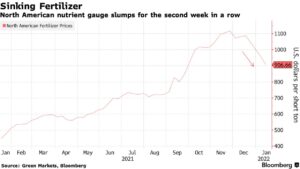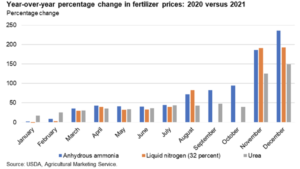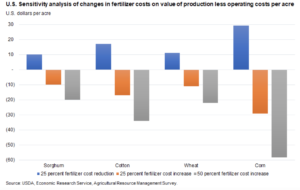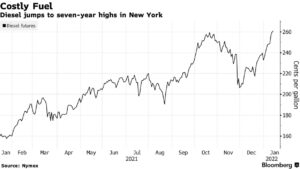Congress has quickly engaged in putting together potential aid packages for farmers that would more than double the Trump administration's $12 billion under the Farmer Bridge Assistance (FBA) Program.
Fertilizer Prices Fall, Diesel Prices Climb
Late last week, Bloomberg writers Elizabeth Elkin and Allison Smith reported that, “North American farmers could be looking at less expensive crop nutrients this year, potentially easing the pressure on food costs that have pushed up consumer prices.
“The Green Markets North American Fertilizer Price Index, which more than doubled in 2021, fell 5.2% Friday after spiraling down the most since 2009 last week. Prices for New Orleans urea, a type of nitrogen fertilizer, fell 6.2% to the lowest since October as reports of full warehouses signal ‘the new price level is here to stay,’ said Alexis Maxwell, an analyst at Bloomberg’s Green Markets.”

The Bloomberg article explained that, “Fertilizer prices soared to repeated records over the last few months, spurred by setbacks including an energy crunch in Europe, unexpected plant closures and halted exports from major suppliers. The increase has stoked concerns over prospects for further food inflation at a time when consumers are already paying more for staples like grains and coffee.”
#Illinois Production Cost Report (Jan. 13th), https://t.co/eOoTGbyarV @USDA_AMS pic.twitter.com/F8pndo6DmR
— Farm Policy (@FarmPolicy) January 15, 2022
Meanwhile, the USDA’s Economic Research Service stated in its monthly Feed Outlook report last week that, “Fertilizer costs have increased throughout 2021, particularly over the last 6 months. [The figure below] charts spot fertilizer prices reported in Iowa over a 10-year period, as published by the USDA’s Agricultural Marketing Service (AMS).

“Anhydrous ammonia, considered a critical component for most crops, has seen the steepest cost increase from year to year, with an increase from the December 2020 monthly average of $449.1 per ton to $1506 in December 2021, a 235 percent annual increase. Liquid Nitrogen (32 percent) had a cost increase from the December 2020 monthly average of $232 per ton to the latest reported price in December 2021 of $677.5 per ton, representing a 192 percent annual increase.”

The Outlook report indicated that, “The higher cost of fertilizer is expected to impact the cost structures for all commodities, which has implications for producer planting decisions.”
ERS added that, “Referring to [the figure below], a 25 percent increase in fertilizer prices results in: A decrease of $9.95 per acre in value of production (less operating costs) for sorghum in the United States, a $17.63 decrease in per acre value of production (less operating costs) for cotton, a $11 decrease in per acre value of production (less operating costs) for wheat, and $29.23 decrease in per acre in value of production (less operating costs) for corn.”

With respect to other costs associated with agricultural production, Bloomberg writer Chunzi Xu reported last week that, “Trucking, farming and heating homes is set to get more expensive as diesel prices surge to highs not seen since 2014.”

“Diesel prices have risen as U.S. refiners began a heavy maintenance season this month, when fuel stockpiles are already at eight-year lows. A fire at one of the country’s largest refineries took out even more fuel-making capacity at the end of last year,” the Bloomberg article said.





